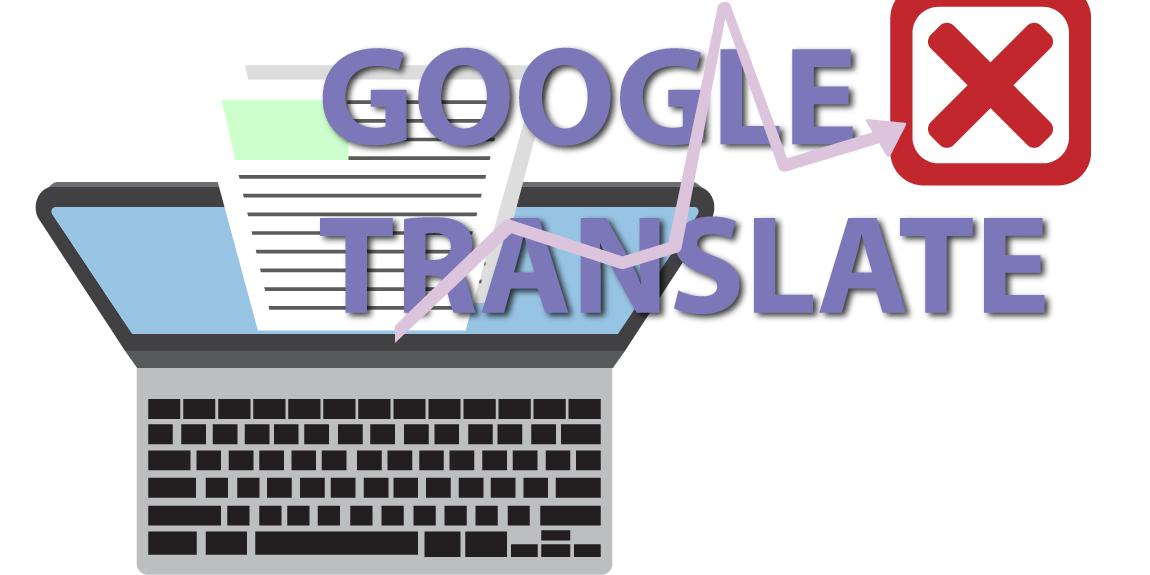According to Wikipedia, “Google Translate is a free statistical machine-translation service provided by Google Inc. to translate written text from one language into another.”
Avoid disappointing your customers by using Google Translate
As long as the translation is done by a machine, we know that it cannot be done by applying grammatical rules, but through complex algorithms which are based on statistical analysis. You cannot ask more than that, especially if it’s free.

Machine translation results
When it comes to your personal documents or your business’ translations it’s not the safest idea to use automatic translations. Although many people know this, there are some companies and governments that gave it a try and the results weren’t even close to “OK”.
Most of the time, the use of Google Translate causes the target audience to think that it is just rude and a lack of respect for them. Not only because of the lack of investment for professional translation, but also the fact that the translated versions are not even verified.
Some examples of awkward situations
-
- The Catalan government considered it would be better to make the translation of their website using Google Translate. And so they did. But the results weren’t the ones they expected. According to the translation, former president Josep Tarradellas became “George Washington” and agriculture minister Josep Maria Pelegri was introduced as “Joseph and Mary Pilgrim”. The government had to justify their actions by saying that the use of machine translation was temporary.
-
- Another one of the many mistranslations appeared on the Spanish version of Courant.com in this passage: “El hombre florero Over Head Smashed novia, policía dice” which means “The man flower vase Over Head Smashed Girlfriend, police said”.

-
- Mistranslations also occurred when the Malaysian Ministry of Defense launched its new website showing its military status, along with the English version. In one section of the translated version it was mentioned that the Malaysian Government had taken “drastic measures to increase the level of any national security threat” after the country’s independence in 1957.
-
- In some situations, proper names end up being translated by Google when they should be left alone. An example would be with the brand name “Continental Clothing”, an important manufacturer and distributor of T-shirts and casual clothing, when it was translated in two instances as “Gildan” and “American Apparel”, both existing on the market as competitors.
Google Translate is a great tool for everyday vocabulary or for fun but not for website, legal, medical or financial translations, especially when the program isn’t used by a person that knows the target language.
The best way for those who need a translation service is to hire a serious translation company with experience and a good reputation.
Cons of Google Translate
Google Translate makes mistakes. The quality of Google Translate differs from language pair to language pair. The tool may provide an accurate summary of an English-to-Spanish translation. Billions of words for each language can quickly be found in cyberspace. Not so for Danish and Romanian. Or Turkish and Thai. Users who need a translation for unique language pairs may find Google’s translation tool worthless.
Google Translate doesn’t offer the user any quality control. The search giant’s massive market dominance drives the user to trust its offerings completely. But a user has no idea of knowing whether Google’s German translation of English text is any good. Merely getting a result – any result-in no way confirms that the result is the best.
Google Translate is not private. When you paste your text to Google Translate, you’re effectively saying, “Here you go, Google! Take this work contract!” Read Google’s terms for yourself.
Send us your request today and we will offer you the quality translation that you need. Contact us and a Project Manager will get back to you with a quote. We are available 24 hours a day. Don’t use Google Translate for your business needs unless you want to start loosing customers.
Machine vs. Human Translation
Google Translate has revolutionized the way we approach language translation, providing instant access to translations in a wide range of languages. While it offers quick and convenient translations, there’s no substitute for the nuanced understanding provided by a human translator. Professional translators ensure accurate translations that go beyond literal translation, capturing the essence of the source text while considering cultural nuances. Particularly crucial for legal translations, human review ensures precision and reliability. Despite advancements, online machine translation tools may still produce poor translations with grammatical errors. However, with deep learning algorithms and continuous improvement, the accuracy of translations provided by machine translation tools is steadily increasing, offering correct translations for everyday language and technical documents alike.
Context in Translation
Cultural context plays a vital role in translation, influencing how messages are interpreted and understood. Beyond language, factors such as customs, beliefs, and social norms must be considered. When dealing with file types, including documents, images, and multimedia, it’s essential to choose translation services that can accommodate a wider range of formats. Platforms that allow users to drop files directly for translation offer convenience and efficiency. In contexts like business negotiations or SEO strategy, accurate interpretation services ensure that communication is effective and goals are met. For a business owner, a damaging translation error can have significant repercussions, underscoring the importance of employing human editors and development translation services. Whether in formal settings or casual conversations, the accuracy of translations is paramount to maintaining professional relationships and avoiding misunderstandings.
FREQUENTLY ASKED QUESTIONS
Google Translate can provide basic translations, but it may not always capture nuances or context accurately. It’s best used for getting the gist of a text rather than relying on it for precise translations.
While Google Translate can be a helpful tool, relying solely on it for important documents can lead to errors or misinterpretations. It’s essential to have human editors review translations to ensure accuracy and avoid any potential damage to the document’s credibility.
Google Translate may struggle with complex or technical content, idiomatic expressions, and languages with subtle nuances. Additionally, it may not handle formal or legal documents accurately, potentially causing damage to the integrity of the text.
To minimize the risk of damage, it’s advisable to use Google Translate as a starting point and then have the translation reviewed by a professional translator or editor. Avoid relying solely on Google Translate for critical documents or communications.
If you suspect a damaging translation error, it’s essential to address it promptly. Consider consulting with a professional translator to correct the error and mitigate any potential damage caused by the inaccurate translation.








